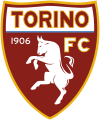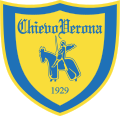Football derbies in Italy
This article deals with the five city derbies that have taken place in the top division of Italian club football and the national Derby d'Italia . The most common city derby in the history of Serie A is the match between AC Milan and Inter Milan . Since the introduction of Serie A in the 1929/30 season , this derby has been held almost every six months. The Milan derby was not played only between 1943 and 1945, when the league was suspended for two years due to the Second World War , and in the seasons 1980/81 and 1982/83 , when AC Milan had slipped into the second division .
Another match of Serie A that is almost regularly held is the Roman Derby, which has been almost regularly accompanied by brutal riots in recent years and is considered the most critical city derby in Serie A. There are other traditional city derbies - albeit not regularly - between Italy's record champions Juventus and Turin FC as well as Sampdoria and Genoa . The derby between Chievo and Hellas Verona has only been held twice in Serie A so far . Because Chievo is an upstart who has risen several times from a lower class, who appeared for the first time in the 2001/02 season in Serie A, while Hellas went the opposite way and after several ascents and relegations in the 2010s again since 2017 Serie A is playing.
The chapters are sorted based on the alphabetical order of the cities included. The Derby statistics are based on the reference date June 30, 2009. However, it should generally be noted that statistics of this type should always be treated with caution, as they often differ depending on the source. Nevertheless, they give an overall impression of the sporting comparison of two teams vying for the public in the same region. The team that had a more successful derby record was always named first. In the case of Verona, Chievo was named first in alphabetical order, as the balance there is absolutely even.
In the 2017/18 season of Serie A there are 5 cities, each with 2 clubs and thus half of the top division, these are Milan, Turin, Genoa, Rome and Verona.
Genoa
The Genoa FC 1893 was founded by the English and took on Italian members for the first time four years later . The club, which won six of the first seven championships in Italy and recorded a total of nine championship titles (the last one in 1924), was particularly anchored in the Genoese old town from the start. Another football stronghold in the region was in Genoa's western districts, where the two clubs began, which merged immediately after the Second World War and have since appeared as Sampdoria Genoa . Even today, Genoa is primarily considered a city club, while Sampdoria's fan strongholds are in the west of the city and in the suburbs. The Genoese Derby della Lanterna is named after the lighthouse in the harbor , the city's landmark.
Record of the Derby della Lanterna
- Total games: 82
- Wins Sampdoria: 30
- Draw: 33
- Genoa wins: 19
- Goals Sampdoria: 97
- Goals Genoa: 77
Milan
The Milan Derby was named after the statue of the Madonna on the central spire of the Milan Cathedral and is the only duel between two clubs from the same city that both won the Champions League . It is also the only city derby in Italy that has already been played in the European Cup. In addition, both teams play their home games in San Siro . In contrast to the other derby cities in Italy, in which the fan camps are more or less geographically determinable, the crack in Milan runs right through all the districts, and no club has particular strongholds. However, for a long time there was a rough distinction in terms of social status and political convictions. Because Inter was traditionally the association of citizens, artists and entrepreneurs. On the other hand, Milan mainly had friends in the working class. Lately, these fundamental differences have also blurred. Since Berlusconi's entry in February 1986 , Milan has also developed an attraction for right-wing movements. In addition, a study carried out in 1992 found that the proportion of industrial workers among the members of Inter Milan is 34.4 percent, compared to only 22.3 percent at AC Milan. The proportion of employees at Inter is, at 30.5 percent, significantly lower than at Milan with 39.4 percent. Shop owners are also represented much more strongly at Milan with 16 percent than at Inter with only 9.1 percent.
Record of the Derby della Madonnina
- Total games: 299
- Wins Milan: 112
- Draw: 81
- Wins Inter: 106
- Goals Milan: 448
- Goals Inter: 427
Rome
The club that is more popular with the city's population is AS Roma , whose original home is in Testaccio , a working-class district in the south of the city. Due to its origins, the club is traditionally particularly anchored in the working class, and its audience is more likely to belong to the political left. However, this statement does not apply to the hard core of his extremely feared Ultras , which are just as right-wing as the equally feared ultra scene Irriducibili of city rivals SS Lazio , whose home is in the affluent Parioli district in northern Rome .
Record of the Derby della Capitale
- Total games: 152
- Wins Roma: 55
- Draw: 56
- Wins Lazio: 41
- Goals Roma: 190
- Goals Lazio: 146
Turin
The rivalry in Turin shows interesting parallels to the situation in Munich . So has FC Turin deep roots in the city, similar to TSV 1860 München in Munich while Juventus , much like the Bayern Munich , has the highest popularity in the country. The fan groups located in the greater Turin area differ roughly as follows: Turin FC traditionally has greater support from the long-established city population, while Juventus - which has been owned by the Agnelli family, which has controlled the Fiat group since 1923 - has greater affection with the families who have immigrated from southern Italy , most of whom live in the newer residential areas of the suburbs and whose breadwinners are in most cases under contract as workers at Fiat. Despite their working-class fans who have immigrated from southern Italy, Juventus has always been regarded as a club of the upper class and Turin FC as a traditional representative of the working class that has been rooted here for generations. In addition, different political currents characterize the ultras of both clubs, which are more right-wing at Juventus and mostly left-wing tendencies at Torino.
Record of the Derby della Mole
- Total games: 225
- Juventus wins: 91
- Draw: 62
- Torino wins: 72
- Goals Juventus: 341
- Goals Torino: 309
Verona
For the first time there was a Verona city derby in Serie A in the 2001/02 season . It was the first first division season in the history of the surprise promoter Chievo Verona , who finished fifth and secured a place in the UEFA Cup . After Hellas Verona had been promoted and relegated several times in the 2010s, there will be another local derby in Serie A in the 2017/18 season. Nevertheless, the derby balance of both clubs in Serie A is balanced: while Hellas won the first leg (despite being 0-2 deficit) 3-2 in his favor, Chievo won the second leg (after 0-1 deficit) with 2: 1. Hellas has always been an association of the entire city, while AC Chievo, based in the north-west of Verona, was actually only a representative of its quarter of the same name . The fact that the new club was so quickly accepted by the public - in its first first division season 2001/02 it was able to look forward to an average attendance of around 16,000, while the established Hellas FC was not significantly higher at around 18,400 - is primarily due to the behavior of the hard core of the Hellas Ultras. With their radical right-wing and racist demeanor, they frightened many Veronese viewers, who have since preferred to watch the Chievo games, where initiatives against racism take place.
Record of the Derby di Verona
- Total games: 10
- Wins Chievo: 4th
- Draw: 2
- Wins Hellas: 4
- Goals Chievo: 13
- Tore Hellas: 13
Juventus Turin versus Inter Milan
The term Derby d'Italia first appeared in the 1960s when Juventus Turin was the most successful club in Italy and Inter Milan the most successful Italian club on an international level. It was created by the journalist Gianni Brera .
But even in the 1930s and 1950s, both clubs were regular competitors for the Italian championship. To this day, both teams also occupy the first two places in the all-time Serie A table , and until Juventus' forced relegation in the wake of the 2005/2006 manipulation scandal, the two clubs were the only teams that were represented in every Serie A season.
The duel was particularly explosive in the 1960/61 season : Inter, Juventus and AC Milan fought for the championship for a long time. Towards the end of the season, the Derby d'Italia should decide the championship. Too many spectators crowded into the Turin stadium for this game and after a shot from the post by Inter there was a storm, which caused the referee to abandon the game. As usual, the game was rated 2-0 for the visiting team, with the Milanese taking the lead in the table. However, the Italian association under President Umberto Agnelli , who was also President of Juventus, ordered a replay the day before the end of the season. Inter, which had been completely upset by these events, lost their last league game, Juventus played a draw - Turin were champions. Out of anger, Inters President Angelo Moratti then ordered that the Milanese should only play with a youth team in the now meaningless replay. Juventus won this game 9-1.
Record of the Derby d'Italia
- Total games: 215
- Juventus wins: 95
- Draw: 53
- Wins Inter: 67
- Goals Juventus: 307
- Goals Inter: 270
See also
literature
- Omar Gisler: Football Derbies - The 75 Most Football Crazy Cities in the World (Munich 2007) ISBN 978-3-7679-0883-3
- Peterjon Cresswell and Simon Evans: The Rough Guide to European Football (A Fan's Handbook 2000-2001) ISBN 1-85828-568-2
Web links
Individual evidence
- ↑ Balance of all competitive game derbies according to footballderbies.com
- ↑ [1]
- ↑ Richard Giulianotti, Norman Bonney and Mike Hepworth: football, violence and social identity (London 1999), p. 77 ISBN 0-415-09838-6 (on page 76 of this book - contrary to other sources, e.g. Cresswell and Evans, p. 350 (see under literature) - reports that Milan originally represented both the upper class and the working class, while Inter was anchored in the middle class).
- ↑ Derby della Madonnina
- ↑ Complete derby balance according to footballderbies.com; missing games added
- ↑ Complete derby balance according to RSSSF.com
- ↑ All point game derbies between 1994/95 and 2001/02 were taken into account
- ↑ Internazionale vs Juventus - "Derby d'Italia" divides the whole country. In: FIFA.com. Archived from the original on March 9, 2011 ; accessed on March 8, 2018 .
- ↑ The story of the bad blood between Juventus and Inter Milan
- ↑ Balance of all derbies according to Juworld.net








